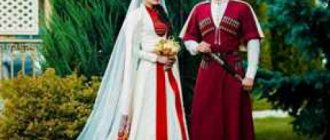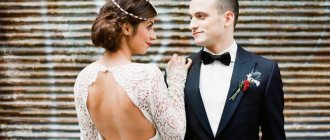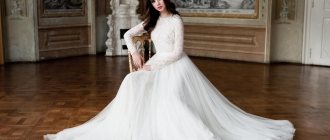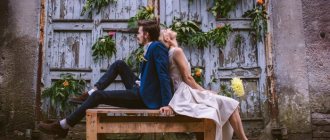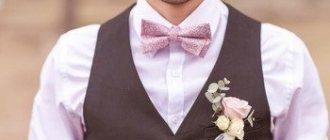The Ossetian people sacredly honor the customs of their ancestors. An Ossetian wedding is divided into several stages, which take place in a certain sequence. A prerequisite is the matchmaking of the bride.
In modern reality, young people can make their own decisions in their lives, however, the relatives of a young Ossetian couple must certainly discuss the terms of the ceremony among themselves.
What does it consist of?
Content
An Ossetian wedding dress consists of many details. The most significant of them:
- corset;
- decorative bib;
- shirt;
- caftan;
- metal belt;
- apron;
- sleeves;
- veil;
- cap.
The entire suit is made in a swing cut. The caftan is worn over the shirt and tightens the bride's figure. It is almost invisible from under the dress. The caftan fits tightly to the body and prevents the chest clasps from coming undone. They are considered more decorative rather than functional elements of the costume.
On top of the shirt under the caftan, the bride wears a corset. It is fastened with a cord or braid, on which numerous knots are tied. According to tradition, the corset must be untied without the use of sharp objects and the cord must not be broken.
The swing dress features hanging, flared, wide sleeves and a nipped waist. In some decorations, a narrow straight sleeve is allowed, which is noticeably slanted at the wrist. On a narrow sleeve it is necessary to put on wide sleeves from the very elbow.
The Ossetian bride wears a cap on her head, which is framed by a veil and decorated with gold and silver threads. There are many traditions associated with the headdress. It served to ransom the newlywed at the wedding, and if it fell into the wrong hands, it was believed that there would be trouble. The cap is made in the shape of a truncated cone and should be red.
The belt protects the bride from evil glances and the machinations of ill-wishers. It can be made of fabric or silver. The richer the belt, the more abundantly it is decorated with stones, the more prosperous the girl’s family and, therefore, the wealth will accompany the young people all their lives. The fabric belt is a masterpiece of embroidery and decoration, while the metal belt looks like the work of a jeweler.
General information
Relatives or close friends of the groom must come to the bride’s house three times before they receive the consent of the girl’s relatives for the marriage. Each time they are greeted cordially, but they do not talk about the final decision; each time the next meeting day is set.
The main topic under discussion is the size of the ransom (kalym). Depending on how quickly the future spouse collects the required amount, a date is set for the next visit.
The final agreement occurs only on the last visit, at which time the wedding date is set. It is believed that the conspiracy took place only after the groom’s relatives gave the bride’s family the bride price. Accordingly, from that moment on, the girl is considered to be engaged. After matchmaking, the future wife leads a completely different lifestyle, not having the right to attend any entertainment events where she can meet the groom’s relatives.
The next stage is considered to be a secret meeting of lovers. Its essence is that the groom, accompanied by close friends, secretly visits his beloved girl to present her with an engagement ring.
Usually, an Ossetian wedding is celebrated simultaneously in both the groom’s house and the bride’s house. As a rule, weddings in Ossetia are very numerous and even those who have not received an official invitation can attend them. At the same time, the owners should be friendly and hospitable.
On the wedding table, in addition to a variety of treats, there must be three pies, symbolizing the sky, sun and water.
The event begins at the guy's house, from where the groom, accompanied by the best man, groomsman and named mother, goes to his beloved's house. There, after performing a special prayer, they are seated at the festive table. The bridesmaids dress the bride in her wedding dress.
The outfit of the Ossetian bride is unique in its beauty and sophistication and is made in accordance with the legendary epic. Modern grooms rarely wear national costume, but girls do not betray ancient traditions. The bride in her wedding dress resembles a dove, in whose image the princess once appeared, according to an ancient legend.
Peculiarities
The image of the Ossetian bride is richly decorated with symbols. First of all, it contains a symbol of fertility, since the main purpose of a woman is procreation.
The bride's dress is decorated with embroidery resembling branched horns. It decorates the edges of the robe and serves as a powerful amulet. The cap on the newlywed's head is also decorated with amulets - they are embroidered with gold and silver threads and decorated with bright stones, preferably a ruby hue.
The dress is divided into three parts: top, middle and bottom. In the wedding attire, the Ossetian bride's outfit has zones that are divided by a cap, a collar and a belt.
It was believed that on the wedding day the bride was especially susceptible to the machinations of evil spirits and was very vulnerable. That is why the abundance of amulets and protective symbols is considered a special feature of a wedding dress.
Celebration
The wedding celebration begins by inviting in advance the respected people who will be in the cortege.
The most venerable one is declared the head of the train, who will take on most of the speeches, as well as solving problems. These men gather a few days before the start of the holiday and discuss all the nuances of the celebration, and also share responsibilities among themselves.
The wedding cortege begins its journey from the groom's house, trying to inform others as much as possible about the reason for their trip. When they reach the bride's house, they are met there by family elders and honorable guests, who present special treats to the visitors:
- three pies;
- beer;
- araka (alcoholic drink made from grain);
- national snacks.
At the moment of donation, praise is offered to God and a prayer is made that this house will always be welcome to visit such esteemed guests. When the leader of the cortege accepts the gifts, he expresses gratitude for the greeting. After this, the man blesses the families who are going to become related.
The rest of the men who arrived should do the same. After all the gifts have been handed over, the guests are brought into the house, where a laid table with treats awaits. It is desirable that there are many different dishes present. This will show that guests are welcome, and good housewives live in the house. When everyone is seated, songs and toasts begin, while the mother of the bride tries to make the eldest of the train feel comfortable.
It says that a celebration is planned, but he respects the grief of others and does not know what to do correctly. After that, they send him a response in the same way with permission to celebrate, because they respect other people’s happiness.
When some time has passed, the head of the train asks for three ribs of a sacrificial ram. After they are brought to him, he divides them and hands them along with the glasses to the women of the clan. At this time, three toasts are made:
- Praising the women and girls who prepared the festive treat.
- To all guests.
- The eldest woman in the bride's family.
At this time, some of the women help the bride to dress up, and when she is ready, it is announced. After this, the elder must pay the agreed ransom, and only after that the girl will be shown to them. At the same time, it is desirable that during the bargaining process emergency situations occur that will amuse everyone present.
When the motorcade enters the courtyard, the car is surrounded by young people who sing funny songs and joke. The bride is brought to 3 older men who read a prayer to God in gratitude for the joyful event. After this, the bride is helped to carry out the process of removing the veil and taken to the house where the 3 oldest women are sitting.
Before she crosses the threshold, she is given a little boy to hold, so that the first child will be male. After that, she must cross the threshold, and it is important that she enters the house with her right foot, without tripping. When the girl is under the roof, she immediately bows deeply to each elder, showing respect
In response, she hears prayers to God, in which they thanked him for such a well-mannered girl. Next, the bride is escorted to a designated room and dancing is arranged. After a certain time, the train foreman comes for the bride and takes her out into the yard to remove the veil.
He removes the veil using a special flag sent from the bride's home. At the same time, he wishes her fertility, many sons and one daughter. The flag used to remove the veil is solemnly hung in the house above the stove.
After the bride's veil is removed, she must present the elder women with a bowl of honey, which was sent from her parents' house. At the same time, the elders wish her to have the same sweet life in marriage. Next, the girl is escorted to the room where dancing and singing continue. While the bride is being welcomed into the groom's house, the man comes with a witness to the bride's house. They are waiting for him there, because everyone is interested in how the new relative will turn out. A guy should show modesty and moderation in food and alcohol so as not to show himself in an unattractive light. It is after this banquet that his relatives and neighbors will determine their opinion towards him.
A man, having arrived at the house, must present the women with candies or other sweets. After this, in the midst of the celebration, he and two friends ask to get up from the table, looking at the women. There they are given 3 glasses, and they must make 3 toasts to the hostesses, and then fill the dishes with money. The men return to the table and continue to celebrate.
Colors and fabrics
The caftan in traditional outfits is made from expensive natural fabrics. Mostly it is silk, satin or velvet. The sides of the caftan, hem and collar are decorated with galloon and gold embroidery. The belt could also have various decorative elements. Under the caftan, the newlywed wears a cotton or silk shirt of yellow or red color. The corset for the caftan is made of silk folded in several layers.
The swing wedding dress was originally made from red material. But fashion has made its own adjustments. Today, the Ossetian bride's outfit is made in light colors with bright elements. You can meet Ossetian women in cream, blue, and pink wedding dresses. But still, most girls prefer snow-white wedding national decorations made of expensive materials.
Photos of Ossetian wedding dresses 2022
In the modern age, Ossetians are faced with a choice: to prefer a European wedding dress to traditional Ossetian vestments or not. However, most girls choose the national costume, the history of which goes back hundreds of years. And this choice is quite obvious, because the Ossetian dress with symbols of the sun, fertility, abundance, and happiness serves as a talisman. Luxurious gold embroidery, decoration with pearls and Swarovski stones on national wedding dresses cannot be compared with any modern dress.
Accessories and shoes
Ossetian wedding dress is decorated with precious stones, silver and embroidery. This makes the outfit not only rich and luxurious, but also quite heavy. Precious stones should be replaced with decorative artificial elements. For example: Swarovski stones, rhinestones, pearls or beads.
The outfit should traditionally come with a silver belt. It is decorated with gilded ornaments and embossing. The belt can also be decorated with red stones.
The Ossetian bride wears chuvyaki on her feet - soft national shoes made from natural fabrics. Following strictly traditions, chuvyaki should be made from a single piece of morocco and decorated with national ornaments. The patterns are embroidered with gold and silver threads.
The bride's veil can be replaced with a transparent scarf. It is put on over the cap and completely hides the girl's face. After the wedding ceremony, this scarf is removed, and instead of it, the cap is covered with a red velvet piece of fabric.
Bride kidnapping stage
The theft of a bride from the Circassian people, unlike many others, is still relevant today. The theft scenario is different from the well-known film. Usually the second previously mentioned option occurs, in which the couple has been communicating for a long time and after a period the groom expresses a desire to kidnap the girl for the wedding. At the same time, without hiding his intentions from her. After the stage of kidnapping the bride, a delegation from her side must come and ask for consent to stay in the house further.
If the bride answered positively, then the delegation informs the family about her decision and preparations for the wedding ceremony begin. The girl’s relatives must not only collect the dowry, but also purchase gifts for the groom’s side. The betrothed's side also celebrates the event with a feast and inviting guests to the celebration. The duration of the fun can reach from 3 to 5 days until the big day.
Hospitality
Ossetian traditions and customs are strictly observed from generation to generation. According to the law, no one under any circumstances dares to offend a guest. If this happened (which was very rare), the entire village gathered to try the culprit, a verdict was passed, the culprit’s legs and arms were tied and thrown from a cliff into the river.
The owner protects the guest and would rather die than betray the person knocking on the house out of necessity. Ossetians are generous and honor those who cross the threshold of their home. They greet the guest with the following words: “My home is your home; I and everything mine are yours!
If the guest stays overnight, the owner is obliged to slaughter the sheep, even if he currently has fresh meat.
No one will dare refuse a person who knocks on the door. The law of hospitality is sacred for Ossetians. If the owner received an unknown person in his house, and then found out that he was his blood enemy, who needed revenge, in this case, the owner cordially treated the visitor and would definitely shelter him.
Project "Ossetian national men's costume"
We are accepting applications
Apply now
For students in grades 1-11 and preschoolers
Chapter 1.
Ossetians are one of the nationalities of the North Caucasus………
Chapter 2.
National Ossetian men's costume…………….
The national Ossetian costume is a kind of bridge between the past and the future. It carries within itself the characteristics of the traditions, customs and spiritual culture of the people.
In our work we showed the originality of the national men's costume.
Subject of study -
national Ossetian men's costume.
Analysis of literature and materials from Internet sites.
Observations and conversations.
The purpose of the work is to explore the history and features of the national Ossetian men's costume.
Main objectives of the study:
- study literature on the history of nationalities and their costumes;
- characterize individual parts of the Ossetian masculine
— examine the level of knowledge of 2nd grade students on the subject of knowledge
Ossetian men's suit;
- prepare a presentation of the work.
Chapter 1. Ossetians are one of the nationalities of the North Caucasus.
Famous people
Quite a few Ossetians became famous throughout the world for their talents and outstanding deeds, and became examples of pride and imitation for posterity:
- Khadzhiumar Mamsumov, twice Hero of the USSR, Colonel General, known as “Colonel Xanthi”;
- Issa Aleksandrovich Pliev, twice hero of the USSR, army general.
During the Great Patriotic War, 75 natives of the Republic of Ossetia received the title of Hero of the USSR.
The following personalities are known in science, art and culture:
- poet Kosta Khetagurov;
- writers Dabe Mamsurov and Georgy Cherchesov;
- director Evgeny Vakhtangov;
- conductors Valery Gergiev and Veronika Dudarova;
- film actors Vadim Beroev and Egor Beroev;
- world famous scientist Vaso Abaev.
Ossetians were very successful in sports, especially in wrestling, which is why Ossetia was called a wrestling nation:
- Soslan Andiev, two-time Olympic champion and four-time world champion in freestyle wrestling;
- Baroev Khasan, Olympic champion and world champion in Greco-Roman wrestling;
- David Musulbes, winner of the 27th Olympic Games in Sydney, world heavyweight freestyle wrestling champion;
- Arsen Fadzaev, the first winner of the Golden Wrestler award, 6-time world champion in freestyle wrestling, two-time Olympic champion;
- Soslan Ramonov, world champion and Olympic champion in freestyle wrestling in 2016;
- Artur Taymazov, silver medalist at the 2000 Olympics, two-time world champion, three-time Olympic champion;
- Makharbek Khadartsev, 5-time world champion, 4-time European champion, Olympic silver medalist, 2-time Olympic champion in freestyle wrestling in the 90 kg weight category.
And this is not a complete list of all the outstanding athletes of this sport. In 2008, 20 athletes from Ossetia competed at the Olympics.
Hats
Ossetia is famous for its wide variety of headdresses. National elements for covering the head include hats made of felt (nymat, khud). By the way, these same names of headdresses are found among many Caucasian peoples.
Ossetian shoes are also distinguished by their national originality. At the end of the 19th century, wealthier citizens of Ossetia began to wear galoshes.
The Ossetian national costume is a kind of pontoon between the past and the future. The traditional clothing of Ossetians has many similarities with the clothing of the highlanders of the North Caucasus. This is due to the identity of geographical conditions and the common Caucasian folk basis.
Housing
Ossetian dwellings are whitewashed huts or mud huts, which are located on flat surfaces. In the mountains, where there is no forest or there is practically no access to it, the Ossetian dwelling, or, as it is also called, saklya, is built without the use of cement, from stones and one side is attached to the rocks. Sometimes the side walls are also fused with the mountain.
The main part of the Ossetian house is a large common room, a kitchen combined with a dining room, where food is prepared during the day. This is because Ossetians do not have a specific time for eating, and family members sit down at the table in turns: the older ones eat first, then the younger ones.
In the middle of the room there is a fireplace, above it, on an iron chain attached to the ceiling, a cauldron made of cast iron or copper hangs. The hearth plays the role of a kind of center around which the whole family gathers. The iron chain on which the cauldron hangs is the most sacred object in the house. Anyone who approaches the hearth and touches the chain becomes a person close to the family. If you take the chain away from the house or offend it in some way, this will become a very big offense for the family, for which there was previously a blood feud.
In Ossetian families, married sons were not separated from the family, so gradually, when the sons got married and brought wives into the house, new sakli and buildings were added to the house, including for household purposes. All buildings are covered with a flat roof, on which grain is often dried or bread is ground.
Wedding in Ossetia
It must be said that the Ossetian wedding is very beautiful and spectacular, as well as crowded and hospitable. On special occasions, the number of guests can reach up to 2 thousand, but its main feature is that the celebration takes place in two houses. Early in the morning, a delegation from the groom, consisting of no more than 50 people, goes to pick up the bride, with pies, bottles of beer and araka (Ossetian alcoholic drink), cakes and sweets.
At the bride's, the delegation is met by elders with glasses, who drink from three elders from the groom and in return present their glasses. Then everyone sits down at the table, says the prescribed prayers, eats, after which the young people go to dance. The bride stands in a prominent place all this time and does not take part in the celebration. After the part with feasting and dancing is completed, she leaves to change clothes. The bride's ransom, which is carried out by the senior best man, is not complete. After this, she is led out of the house by two best men, the eldest on the right, the youngest on the left. The elders bless the bride and pray for her.
When the cortege arrives at the groom's house, the bride receives a blessing from the groom's elders. She is given a baby boy in her arms so that the newlyweds will have a son as their first-born.
The next important stages at an Ossetian wedding, according to ancient traditions and customs, are the removal of the veil and the ritual with a bowl of honey and ghee. The young man from the groom’s side brings with him a ritual flag, which must be passed over the bride’s head three times. He then wishes her happiness, abundance, seven sons and a daughter with blue eyes and lifts the veil so everyone can see the girl's face. The flag is kept in the newlyweds' family all their lives. After this, the bride presents honey and butter to the adult women, the last mother-in-law, so that there is mutual understanding between them.
With the onset of darkness, the groom goes to the bride's house, where the mother-in-law cooks him scrambled eggs, and the feast continues. By the way, the bride and groom are not near each other during the wedding and do not speak. They stand separately and congratulations are also accepted one by one. Only after a feast with the father-in-law and mother-in-law, drinking traditional glasses, all ceremonies are considered to be observed.
Respect for a woman
Ossetian traditions and customs are distinguished by deep respect for women.
For example, according to Ossetian etiquette, a rider, seeing a woman, must get off his horse before catching up with the traveler, let her pass him, and only then continue on his way.
If a woman passes by sitting men, everyone stands up in greeting.
At the sight of the old man, the entire seated crowd rises to their feet, and even more so at the sight of the old woman, everyone is obliged to stand up. No matter how drunk the men having fun at the festival may be, no matter how impudently the tipsy youth may behave, even during a strong and violent quarrel between the fighters, the appearance of a woman will tame the grumblers, rowdies and stop the fight.
A woman’s identity is considered inviolable:
- for her labor services in the family;
- due to weak nature;
- due to a cramped position in society.
If the weaker sex needs any help, then the man will help her in everything like a knight.
A little history
Since ancient times, it has been the custom that a traditional Ossetian costume should be made exclusively by women’s hands, and at home. Women initially dyed homespun fabric in the desired colors and shades. This was done using paints exclusively of plant origin. Only after preparing the fabric was it possible to begin sewing national decoration.
It should be mentioned that in the national clothes of Ossetians one can see motifs of the Alanian and ancient Scythian-Sarmatian cultures. From this we can conclude that these outfits have a very ancient origin, which gradually absorbed more and more new trends.
Already in ancient times, national Ossetian costumes were very richly decorated with all available means: embroidery, ornaments, stripes. And at this time, Ossetian clothes look very rich and festive .
Everyday attire of Ossetians
In ordinary life, Ossetian women wore dresses with gathers at the waist, with a delayed stand-up collar, a straight neckline from the chest to the waist and tapering sleeves to the wrist.
Clothing, like many other components of material culture, was influenced by social and material differences. In wealthy homes, things were made from purchased fabrics, expensive silk, velvet and other things. Ossetians wore jewelry made of precious metals, which were inaccessible to an ordinary woman. Men decorated the edges of the Circassian coat and weapons with silver and gold.
Ossetian outerwear
The Circassian coat, known to many, was made from cloth of different colors (black, white, brown, gray and even red). The most valued cloth was made from goat fluff in the mountains, and in some villages (where there were no mountains), for example, in the Mozdok region, from camel wool. The indispensable attributes of the Circassian were a dagger, a belt decorated with silver, and a revolver.
The next item of clothing in the Ossetian national costume is the burka. It is a cape with sweeping shoulders, the length is generally maximum, up to the heels. The Ossetians were not separated from this thing throughout the year; it protected them from precipitation, heat and frost, and for the shepherds it also served as a device for sleeping.
In addition, the burka was considered an integral part of the attire of a nomadic warrior and was the most important component of the clothing of the Ossetian ancestors - the Scythian-Sarmatians and Alans, who brought it to the Caucasus.
The ancient elements of the Ossetian national costume also include a fur coat (or in another way - karts). It was worn in winter as outerwear.



